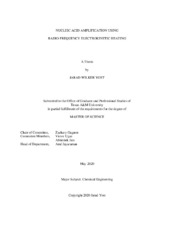| dc.description.abstract | Microfluidic PCR is one of the most common and widely used sample preparation techniques. Most heating methods for microfluidic PCR are heated in one of two ways: (1) the reaction is pumped between different boundary-heating zones, or (2) stationary reaction chamber boundaries are heated by resistive heating elements. Both heating methods are subject to limitations of boundary-driven heating, where an inherent thermal gradient exists between heater and reaction. Therefore, there is a need to develop a simple and rapid PCR heating mechanism that is not subject to limitations of boundary-driven heating.
Alternating current (AC) electrokinetics has many uses in microfluidics, from dielectrophoresis, the study of induced dipoles on a particle in an electric field, to electrokinetic fluid pumping, where conductivity and thermal gradients drive fluid flow. A common side effect of these phenomena is electrothermal heating, or Joule heating. Joule heating is normally avoided in microfluidics due to its adverse effects on the chip system; however, it has been shown to drive microfluidic biochemical reactions. Driving PCR using AC electrokinetics has had limited implementation into microfluidic amplification systems.
Here we show a novel nucleic acid amplification platform that drives amplification reactions using high-frequency (radio frequency) AC electrokinetic heating. Heating occurs by applying a current across the reaction, with electrodes in direct contact with the reaction mixture, a system we call E-NAAMP (Electrokinetic Nucleic Acid Amplification). We demonstrate that the heating system can be used in isothermal amplification reactions (LAMP) and non-isothermal amplification reactions (PCR), with amplification efficiencies rivaling those of traditional thermal cyclers. Additionally, we show that heating produced by the applied current is electrokinetic in nature due to the temperature and voltage relationship that arises from the mathematics of AC electrokinetic phenomenon.
Our results demonstrate that direct heating of amplification reactions by Joule heating at radio frequencies can be achieved with minimal electrode damage or significant enzyme activity loss over the course of a reaction, both of which can occur at lower frequencies. We anticipate this heating method to be able to ramp heating of PCR reactions at rates that can accomplish amplification in under a few minutes. With miniaturization of components necessary to run ENAAMP, a low-cost, microfluidic PCR device can be achieved. | en |


